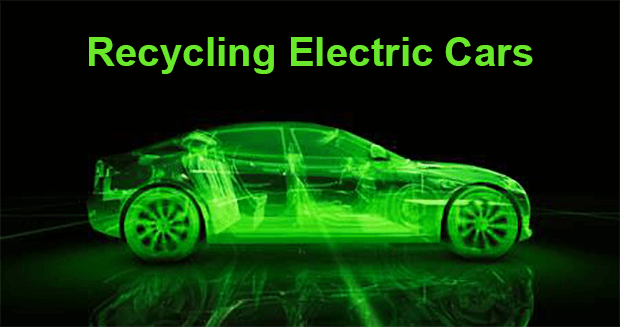Recycling electric cars

Will it be easy to recycle electric cars?
Electric vehicles are on the increase all over the world and with the advent of this new technology we have to wonder if it will be easy to recycle electric vehicles?
The Irish government has committed that 950,000 electric vehicles (EVs) will be on Irish roads by 2030? That would mean that almost 100,000 electric vehicles must be sold here each year for the next ten years? Is such a target even possible? We think not, going on present adoption figures.
At the moment, electric cars are beyond the reach of most drivers as they are far too expensive right now and many motorists are just not in the market for an EV. Besides this, if it were possible to reach such figure, how would we recycle all of these vehicles, especially the batteries as these are not that environmentally friendly.
Figures which came from the ELV Environmental Services (ELVES) showed that 150,000 old cars were scrapped in 2017. Of these, 87% of their components were salvaged and recovered for reuse. Elves is a non-profit organisation that brings together both the recycling industry and the motor trade to ensure that old cars are properly recycled and not just crushed at End of Life.
Although electric cars are mechanically simpler with less moving parts than a traditional combustion engine, it does not mean that it is simpler to scrap. To properly tackle the problem, Elves is going to run a series of training days so Authorised Treatment Facilities (ATFs scrap yards) Elves environmental compliance manager, Elena Wrelton said:
“Elves is very much committed to ensuring that all ATFs across Ireland have access to bespoke and relevant expertise, support, information and training programmes that are industry-specific and pro-actively address key issues impacting the sector. It is of critical importance that those working in the industry are equipped with the resources available to be fully confident and competent in dealing with the correct reuse and recycling of all types of vehicles.”
According to Elves training experts, they have a plan in place to work out exactly what’s needed for each vehicle type and model. One Elves spokesman said:
“How long it takes to remove the industrial battery depends on the location of the battery, its size and the shut-down procedure and these vary from manufacturer to manufacturer. A full electric vehicle also probably has full climate control of the battery, so this also must be factored in when depolluting the vehicle”
“Otherwise, there are fewer fluids to remove – none from the engine, of course – but this can be offset by the size and weight of the battery. Given that this is new technology for ATFs, research would be required on the procedure for that make and model before removal of the battery, and it is likely to add time to the de-pollution process.”
So the car battery is a challenge for EV recycling operators. It is not as if, you can easily pull out the battery and reuse it for a different function or even another car. You can potentially take out a battery and strip it and re-use some of its components, but at the moment the recycling rate for batteries is about 55-60 per cent of the battery parts, which well below the 85 per cent minimum target.
Hybrid cars and plugin-hybrids cars also present further difficulties in recycling. While these type of configurations are better for the environment and even more affordable, their fully electric cousins present the worst of both worlds when it comes to recycling.
“The batteries in hybrid cars tend to be smaller in size and voltage than those in electric cars, and may also be nickel-metal hydride rather than lithium-ion in composition, which makes them easier to handle. The battery in hybrids being smaller in size and voltage and potentially of a different chemistry means there is less manual handling and different health and safety risks related to the battery for the ATF to manage,”
“For a hybrid car, the de-pollution process would the same as a full EV but you would also have an internal combustion engine to depollute. In a hybrid, there may also be multiple cooling systems, for the engine, inverter and possibly for the battery, so this does increase the complexity of the vehicle de-pollution process.”
So the question is, if the governments’ target is reached and we have almost a million electric vehicles on Irish roads in just ten years, will we have enough qualifying recycling centres in the country, trained and ready to deal with this influx of electrics? Here is what Elves had to say:
“The Electric Elves programme is designed to meet the current and future needs of ATFs related to these types of vehicles and is focused on awareness, safe handling and how to access further information and support when they do receive an EV. Given the likely increase, but also the uncertainty as to the speed at which this will happen, Elves will be continually evaluating the programme, and making required changes to ensure it is fit for purpose.”
Author

Justin Kavanagh
Justin Kavanagh is a recognised leader
in automotive intelligence and vehicle
data supply to the entire motor industry.
He has almost 20 years experience in
building systems from the ground up.
As the Managing Director of Vehicle
Management System, he understands the
need and importance of trustworthy and
reliable vehicle history and advice to
both the trade and the public.
Follow me on LinkedIn